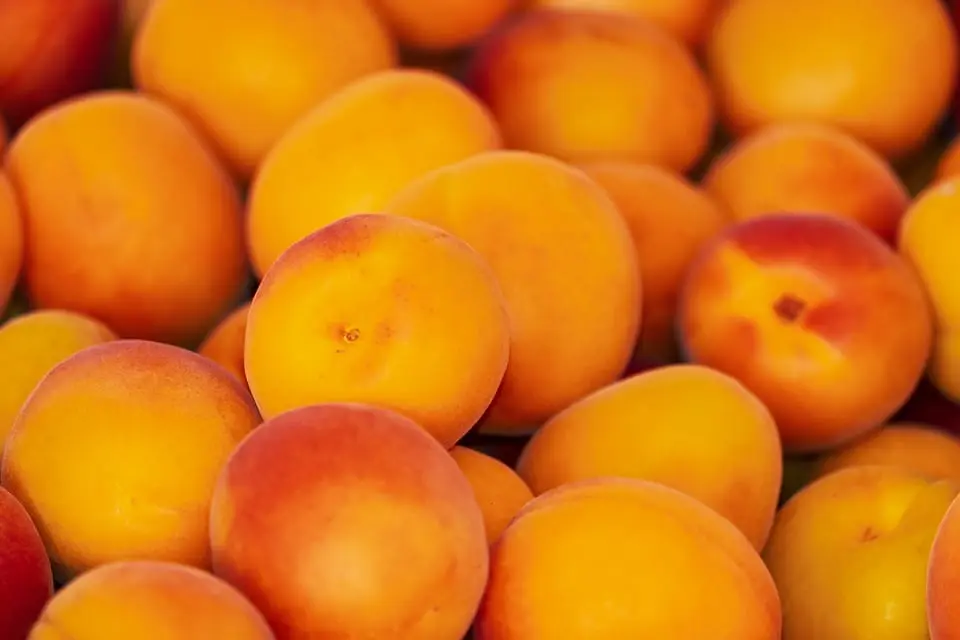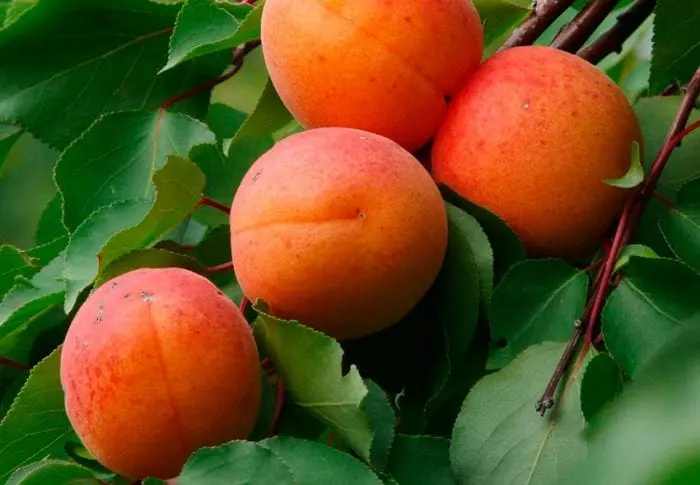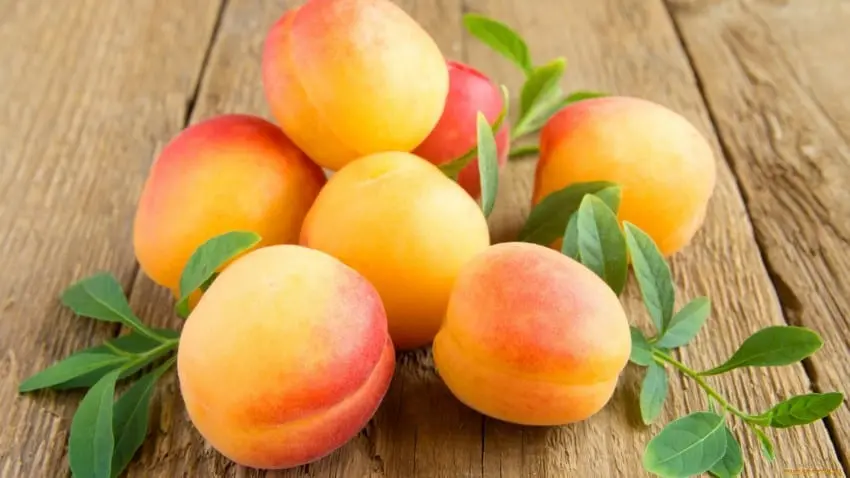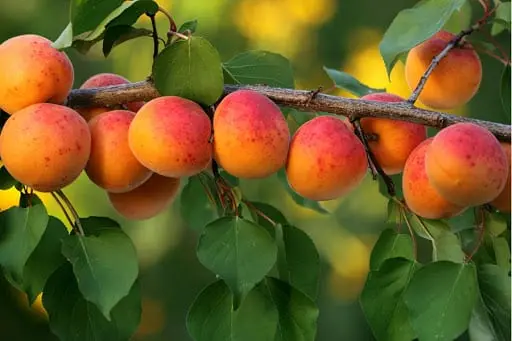Contents
Description
The apricot tree belongs to the genus Plum of the Pink family. The fruits of the apricot tree have a rich yellow or orange color due to their carotenoid content. The shape of the fruit – drupes – is small and round. The pulp can be juicy and sweet or dryish.
According to one version, China is considered the birthplace of apricot, according to another version, it is Armenia. Nowadays, most of the apricots are grown in Turkey, Italy, Uzbekistan, Algeria and Iran.
Composition and calorie content of apricot
Apricots are considered one of the most useful fruits, because they contain: beta-carotene, choline, vitamins A, B3, B2, B5, B6, B9, C, E, H and PP, as well as minerals: potassium, magnesium, iron, iodine, phosphorus and sodium, pectins, inulin, dietary fiber, sugars, starch, tannins and acids: malic, citric and tartaric.
The calorie content of apricot is 44 kcal per 100 grams of product.
- Proteins 0.9 g
- Fat 0.1 g
- Carbohydrates 9 g
- Dietary fiber 2.1 g
- Water 86 g
The benefits of apricot

Apricot contains sugars, inulin, citric, tartaric and malic acids, tannins, starch, vitamins of group B, C, H, E, P, provitamin A, iron, silver, potassium, magnesium, phosphorus. Trace elements are represented by iron salts and iodine compounds.
- Apricot fruits increase hemoglobin in the blood, have a beneficial effect on the process of hematopoiesis, which is very important for those suffering from anemia.
- Apricots increase mental performance and improve memory due to their high phosphorus and magnesium content.
- There is also pectin in apricot, which can remove toxic metabolic products and cholesterol from the body.
- The presence of a large amount of iron plays an important role in anemia, diseases of the cardiovascular system and others, which are accompanied by the development of potassium deficiency.
- Apricots are indicated for gastric diseases and metabolic disorders. They normalize the acidity of gastric juice, which normalizes the activity of the pancreas, therefore, the functioning of the liver and gallbladder improves.
Apricot harm and contraindications

4 main contraindications
- Not every person can benefit from this or that vitamin or microelement. Apricots have not only benefits, but also harm.
- People with diabetes should eat apricots with caution. Although it is a low-calorie food, it contains a significant amount of sugar. The glycemic index of apricot is 30 units (this is the average).
- For the same reason, losing weight with apricots will not work.
- In all acute conditions of the gastrointestinal tract (ulcers, pancreatitis, colitis, gastritis, hemorrhoids, gout, cholecystitis), apricots should be excluded from the diet. If a state of remission occurs, you can eat a few fruits, but only after eating. Also, do not drink them with a lot of water.
How to choose and store
Fresh apricots should be orange with pink cheeks. To the touch – smooth and elastic, without dents or damage. Size – about 5 cm. Small and green apricots have fewer vitamins and minerals, because they did not have time to ripen.
Natural dried apricots and apricots are nondescript grayish dried fruits. Sulfur dioxide gives them an orange color.
Store dried fruits in a tightly closed glass jar that does not let water through. You can at room temperature or put the container in the refrigerator. At temperatures below 10 ° C, the product can be stored for up to 10 months without losing its beneficial properties.
Fresh apricots can also be washed, dried and refrigerated. So they can be stored for 2-3 days.

Another way to preserve food is to freeze it. Fresh apricots should be cut into slices or cubes, then the slices on a tray should be placed in the freezer, when the apricots are frozen, take them out and put in plastic bags. As for the features of frozen apricots, the benefits and harms are the same as in the case of fresh fruits.
Taste qualities
Apricot is a favorite delicacy for children and adults. Its fruits are superior in taste to many other fruits. Fresh soft apricot pulp is very juicy, has a pronounced characteristic taste, aroma and pleasant acidity. Fruits grown in the Fergana Valley and Samarkand are distinguished by their special sweetness and vitamin content.
Dried apricot products (dried apricots, kaisa, apricots and others) are slightly inferior to fresh fruit in taste, with almost equal usefulness. When crushed, they are often used as a sweet and sour condiment for meat dishes and sauces. The juice squeezed from fresh fruit is highly nutritious, has a pleasant and refreshing taste.
In addition to the pulp of apricots, the kernels of their seeds are also eaten. Reminiscent of almonds in taste, they are often added to oriental sweets and nut mixtures. Apricot jam, made from the pulp of the fruit along with the kernels of the seeds, turns out to be especially tasty.
Cooking applications

Apricot fruits are widely used for culinary purposes. The pulp of the fruit is eaten fresh or processed:
- dried;
- cooked for canned dishes (jams, preserves, marmalades, compotes);
- squeezed out to obtain an extract, juices, syrups;
- crushed to add to seasonings;
- fried as part of vegetable and meat dishes.
The seeds of the fruit (pits) are used to obtain apricot oil or are chopped to extract kernels from them, used as a substitute for almonds.
The characteristic aroma and pleasant acidity allow the apricot to be successfully combined with other fruits in desserts, preserves and drinks. Its sweet and sour taste also suits meat and poultry dishes. The aromatic properties of the fruit are widely used in the manufacture of alcoholic and soft drinks.
Such dishes with apricots as marmalades and soufflés, jam with pulp and kernels, pilaf, game in sweet and sour sauce, oriental sweets (sorbet, halva, Turkish delight) are especially popular in cooking. The world famous liqueur “Abrikotin” deserves a special mention.









